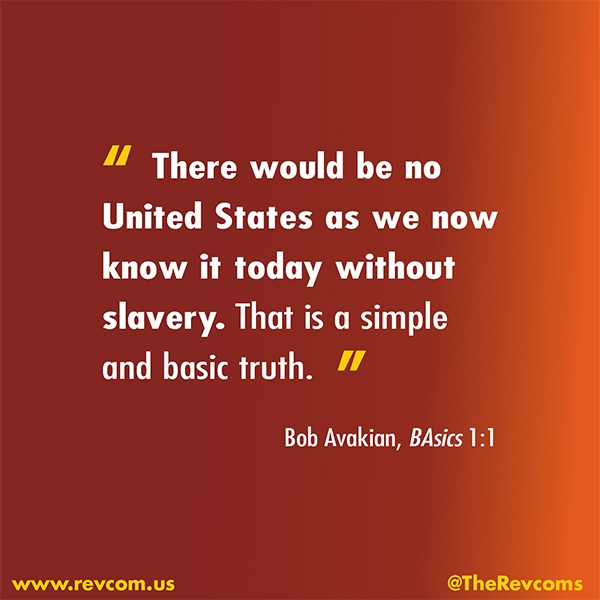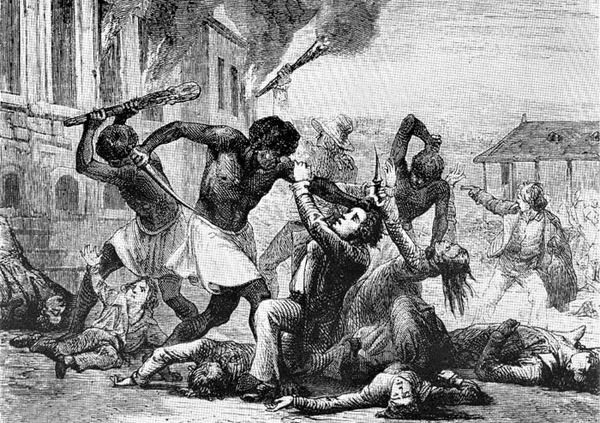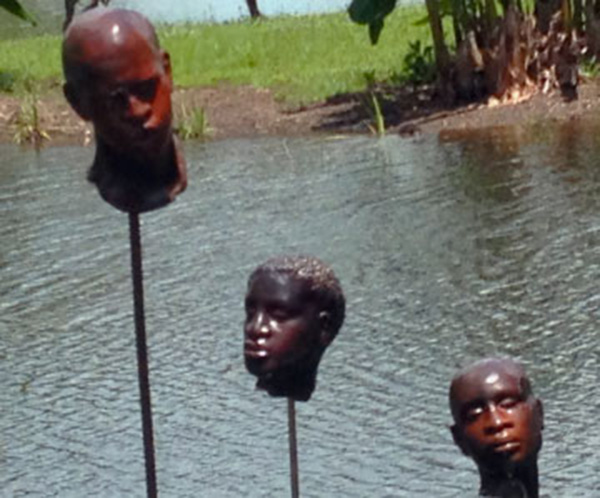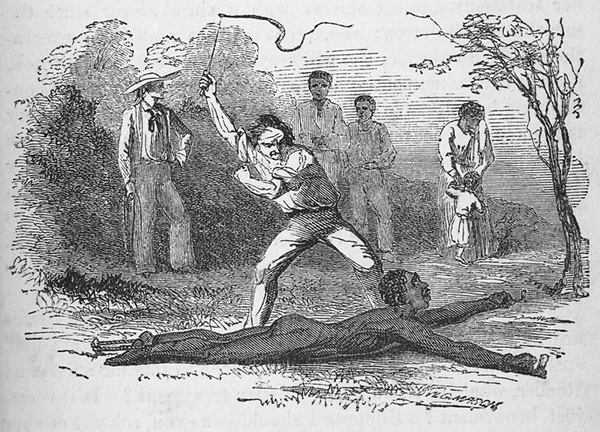Case #22: The Barbaric Suppression of the 1811 Louisiana Slave Uprising
| revcom.us
Bob Avakian has written that one of three things that has “to happen in order for there to be real and lasting change for the better: People have to fully confront the actual history of this country and its role in the world up to today, and the terrible consequences of this.” (See “3 Things that have to happen in order for there to be real and lasting change for the better.”)
In that light, and in that spirit, “American Crime” is a regular feature of revcom.us. Each installment focuses on one of the 100 worst crimes committed by the U.S. rulers—out of countless bloody crimes they have carried out against people around the world, from the founding of the U.S. to the present day.
See all the articles in this series.
THE CRIME
They moved downriver, nearly 25 strong, the heavy night rain silencing their approach. Forty miles from New Orleans, they break into the mansion, run to the second floor where they find and wound with an axe the slave owner Manuel Andry and kill his son. They then break into the mansion’s basement, collect muskets and ammunition, take several horses, and continue to march downriver.
So began, on January 8, 1811, the largest slave revolt in U.S. history, an armed revolt against the slavery system’s barbaric, intolerable conditions. And a revolt the slave owners and U.S. authorities violently suppressed using the most savage means imaginable. The rebels’ political goal was to establish an independent Black republic on the shores of the Mississippi, with a captured New Orleans as its capital.
Manuel Andry was among the French planters who established highly profitable sugarcane plantations in the rich agricultural region known as the Mississippi River’s German Coast. Many of these planters had been forced to flee to the Orleans territory from the Caribbean French colony of Saint-Domingue, where the slaves had risen up, arms in hand, and defeated the planters and armies of the French emperor Napoleon Bonaparte. The victorious rebels renamed Saint-Domingue the free republic of Haiti, abolished slavery, declared racism illegal, and permanently banned the French from the island.
The French planters able to escape and settle in the Orleans territory brought with them many of their slaves. Intent on creating a new Saint-Domingue by maximizing the quantity and quality of sugarcane output, they achieved greater profits than slaveholders elsewhere, their wealth concentrated in huge landholdings, grandiose mansions, and a lavish lifestyle. But to achieve this wealth, they resorted to the same vicious practices they used in Saint-Domingue, turning their slaves into sugar-producing machines on plantations resembling death camps.
At harvest time, the slaves worked 16 hours a day, seven days a week, cutting down the eight-foot-high sugarcane. Laboring in the swamps’ summer heat, they were attacked by mosquito swarms, with many developing malaria and other tropical diseases. If slaves failed to meet their daily quota, or rebelled against their wretched conditions, punishment awaited. For minor insubordination, chained imprisonment for a period of time was likely. For greater disobedience, there was the whip—three stakes driven into the ground in triangular fashion, six feet apart; each hand of the slave tied to a stake, feet tied to the third; then came the lashing with a rawhide whip, creating with each stroke deep cuts seven or eight inches long.
For worse offenders, for those who attempted to escape, for example, there were torture devices they were forced to wear, such as a neck collar with inward-pointing spikes that made it impossible for the slave to lie down and rest his or her head. Finally, beyond the whip or spiked collar was the ultimate form of punishment: death by hanging or other means.
These were the intolerable conditions that led to the uprising of 1811. After having seized guns, ammo, and horses at the Andry plantation, the slaves continued to march downriver, chanting “Freedom or Death!” and “On to New Orleans!” At the plantation of Jacques and Georges Deslondes, the home plantation of Haitian-born Charles Deslondes, an overseer-turned-revolutionary and the insurrection’s major leader, eight slaves joined the revolt.
Small groups of slaves joined from every plantation the rebels passed. Two key organizers of the revolt, African-born Kook and Quamana, led more than half the slaves at their plantation to join, bringing the total number to well over 100. Most estimates are that 200 to 300 slaves joined, although some eyewitnesses and others have said it was as many as 500.
As the march grew in size and strength, terrified plantation owners and their families fled, some hiding in nearby swamps, others seeking refuge in New Orleans. There, on January 9, Governor William Claiborne and U.S. military commanders mustered two companies of volunteer militia, 30 regular troops, and 40 seamen to attack the rebels. At the same time, the wounded Manuel Andry, who had managed to reach New Orleans, worked with other planters who had fled there to form a militia led by mounted cavalry.
By early morning on January 10, these forces had reached a plantation where they thought the rebels had encamped overnight. But the rebels had already started back upriver, nearing another plantation. There, planter Charles Perret had assembled a well-armed militia of about 80 men, who he ordered to attack the insurgents. Despite their greater numbers and some guns, the slaves were not as well armed as their attackers. Only about half had bullets for their muskets, and others carried only sabers, axes, and cane knives. Within 30 minutes, 40 to 45 slaves had been killed, many others had been wounded, another 50 had been captured, and others escaped into the swamp. The militiamen then barbarically chopped off the heads of those they had killed and began pursuit of the others, led by a pack of bloodhounds. They soon found Charles Deslondes, the dogs getting to him first. The militiamen, intent on making a public display of Deslondes, dragged him back to the cane fields where they chopped off his hands, broke his thighs, shot him, then put him on a bundle of straw and roasted him to death.
Kook and Quamana were among those captured and taken to a plantation to be tried. There were three “legal” trials in all, kangaroo courts in reality, quickly ending in executions of most of those captured either by hanging or firing squad, including Kook and Quamana. But whether it was those killed in the initial battle, by subsequent capture and summary executions, as befell Charles Deslondes, or by executions after the trials, the planters and the New Orleans authorities performed the same savage ritual of chopping off the heads of the corpses and putting them on pikes, their mutilated bodies also publicly displayed. By the end of January, nearly 100 heads on pikes were displayed in central New Orleans and for 40 miles along the River Road, into the heart of the plantation district. Wrote one exultant planter, “They were brung here for the sake of their Heads, which decorate our Levee all the way up the coast. They look like crows sitting on long poles.”
THE CRIMINALS
The sugarcane plantation owners: Known to be among the cruelest, most brutal slaveholders anywhere in the South. When slaves farther north spoke fearfully of being “sold down the river,” they were referring mainly to the sugarcane plantations around New Orleans, where they worked longer hours, endured the harshest punishments, and lived shorter lives than most slaves elsewhere in the South. Manuel Andry and Charles Perret stand out for the role they played in brutally suppressing the rebellion.
William C.C. Claiborne: Appointed governor of the Orleans territory by President Thomas Jefferson, and with the population of New Orleans consisting mainly of urban slaves and free Black people, Claiborne feared the opening of a second front, which he believed would doom the city’s white population. He put New Orleans on lockdown and ordered that no Black person was allowed to be in the streets after 6 pm. Claiborne then spearheaded the creation of the voluntary militia and federal government armed force, led by General Wade Hampton and Commodore John Shaw, that hunted down and eventually suppressed, through the bloodiest possible means, the rebel insurrection.
President Thomas Jefferson had appointed Claiborne governor of the territory shortly after the 1803 Louisiana Purchase, when the U.S. bought from Napoleon Bonaparte, for the bargain price of $15 million, what now equals nearly a quarter of today’s United States. The purchase was made by Jefferson primarily in the interests of the slave owners, with the aim of spreading their murderous slave system into new areas of North America.
The legislature of the Orleans territory, which, following the revolt’s suppression, approved “compensation” of $300 to planters for each slave initially killed or ultimately executed.
THE ALIBI
Claiborne and others worked to publicly characterize the revolt as nothing more than the actions of “brigands”—criminals, a band of thieves and marauders. The purpose of the trials themselves was to treat the rebellion as a simple legal matter dealing with a criminal act. This reduction of the rebellion to criminality resonated in the halls of D.C., where no concern was expressed for the real crimes: the slave system itself and the revolt’s brutal suppression.
THE ACTUAL MOTIVE
While the planters and federal authorities worked to reduce the slave rebels in the public eye to nothing more than savage criminals bent on creating mindless havoc, they were fully aware that the revolt was politically motivated, carefully planned, and represented a serious challenge to the system of plantation slavery and its westward expansion. In fact, seeds of the rebellion had been planted long before its outbreak. Kook and Quamana, for example, began planning a rebellion not long after they were brought to New Orleans. They carefully identified like-minded slaves, including during market trips to New Orleans. Similarly, as a trusted overseer, Charles Deslondes traveled openly to plantations, where he cultivated small insurrectionary cells. These cells took as their inspiration the victorious Haitian revolution, were driven by powerful revolutionary ideas, and were prepared to attack in organized fashion and under solemn oath of “freedom or death!” when their leaders gave them the word.
It is precisely because of the highly developed nature of the revolt and its political aim of establishing an independent Black republic that the slave owners and U.S. authorities set out to mercilessly crush the rebellion, to savagely place on pikes the heads of 100 rebels and display their mutilated bodies—providing a glimpse, just a brief but crystal clear glimpse, into the utter barbarity of the slave system.
Sources
Rasmussen, Daniel, American Uprising: The Untold Story of America’s Largest Slave Revolt, Harper Collins Publishers, 2011
Marissa Fessenden, “How a Nearly Successful Slave Revolt Was Intentionally Lost to History,” Smithstonian.com, January 8, 2016
“‘America Rising’: When Slaves Attacked New Orleans,” All Things Considered, NPR, January 16, 2011
Leon A. Waters, “Jan. 8, 1811: Louisiana’s Heroic Slave Revolt,” Zinn Education Project
Wendell Hassan Marsh, “The Untold Story of One of America’s Largest Slave Revolts,” The Root, February 25, 2011


Deslonde Revolt, 1811. Artist unknown

New Orleans authorities responded to the 1811 slave uprising by performing the savage ritual of chopping heads off corpses and putting them on pikes. Nearly 100 heads on pikes were displayed in central New Orleans and for 40 miles along the River Road. The Whitney Museum commissioned Woodrow Nash to create 63 ceramic heads (three shown here) depicting the revolutionaries. They are on stakes beside a pond. (Photo: John McCuster)

If slaves were out of line punishment awaited. Whippings took place: three stakes driven into the ground in triangular fashion, six feet apart; each hand of the slave tied to a stake, feet tied to the third; then came the lashing with a rawhide whip, creating with each stroke deep cuts seven or eight inches long.
From: ON "PRINCIPLED COMPROMISES," AND OTHER CRIMES AGAINST HUMANITY
* Writing in the New York Times “Book Review” section (Sunday, October 25, 2015), speaking about the convention in 1787 that “led to the creation of the United States Constitution,” Robert E. Rubin, former Secretary of the Treasury under Bill Clinton, actually says the following:
“Disagreements about the extent of federal power and the design of our democratic institutions were resolved through long arguments and, ultimately, principled compromises.” (Emphasis added)
Principled compromises?! The founding of this country on the basis of institutionalizing slavery—officially establishing the “right” to own slaves, and the status of slaves as less than human, in its founding Constitution—that is a “principled compromise” in the eyes of a present-day representative and functionary of the ruling class of this country. And the fact is that no major politician and no other significant representative of this ruling class will, or can, denounce this country, since its very founding, and denounce its “founders,” in the terms in which they deserve to be denounced: monstrously criminal. If founding a country on the basis of institutionalizing slavery is not a monstrous crime, what is? The fact that no significant representative and functionary of this system, in this country, can recognize and acknowledge this as a monstrous crime—and instead they all uphold as “great men” those, like Thomas Jefferson, who founded a country on the basis of this monstrous crime, and who perpetuated this crime for generations—that gets to the very core of what this system is all about and why there is a great need to put an end to this system at the earliest possible time, and replace it with a system that has no need, no place, and no apology for slavery in any form.
—Bob Avakian
Get a free email subscription to revcom.us:


